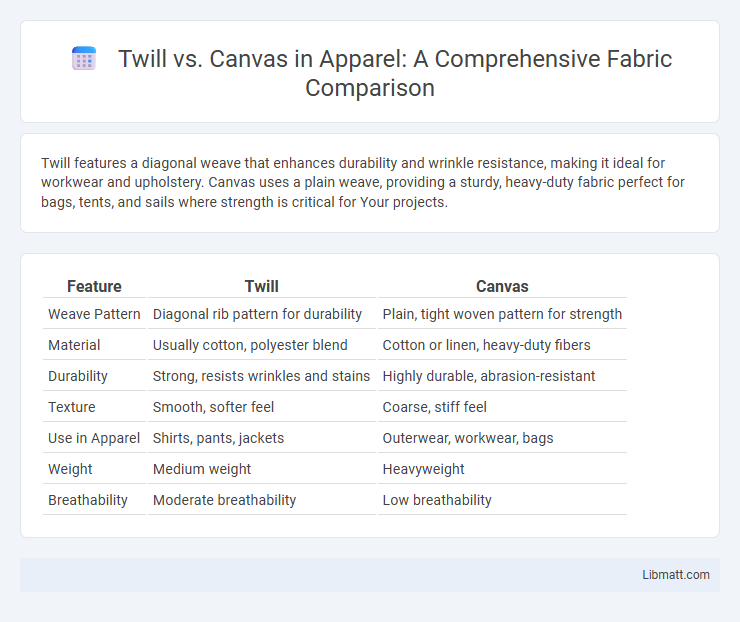Twill features a diagonal weave that enhances durability and wrinkle resistance, making it ideal for workwear and upholstery. Canvas uses a plain weave, providing a sturdy, heavy-duty fabric perfect for bags, tents, and sails where strength is critical for Your projects.
Table of Comparison
| Feature | Twill | Canvas |
|---|---|---|
| Weave Pattern | Diagonal rib pattern for durability | Plain, tight woven pattern for strength |
| Material | Usually cotton, polyester blend | Cotton or linen, heavy-duty fibers |
| Durability | Strong, resists wrinkles and stains | Highly durable, abrasion-resistant |
| Texture | Smooth, softer feel | Coarse, stiff feel |
| Use in Apparel | Shirts, pants, jackets | Outerwear, workwear, bags |
| Weight | Medium weight | Heavyweight |
| Breathability | Moderate breathability | Low breathability |
Introduction to Twill and Canvas
Twill and canvas are two distinct fabric weaves widely used in fashion and upholstery. Twill features a diagonal rib pattern created by weaving weft threads over and under warp threads in a staggered sequence, resulting in a durable yet flexible fabric often chosen for jeans and jackets. Canvas, characterized by its plain weave with equal over-and-under interlacing, provides a sturdy, heavy-duty material ideal for bags, tents, and sails, offering excellent resistance to wear and tear for your rugged needs.
What is Twill?
Twill is a type of textile weave characterized by a diagonal rib pattern created by the interlacing of warp and weft threads. This weave makes twill fabric durable, flexible, and resistant to wrinkles, commonly used in clothing such as denim jeans and workwear. Its tightly woven structure offers strength and a smooth surface, distinguishing it from plain weaves like canvas.
What is Canvas?
Canvas is a heavy-duty, plain-woven fabric typically made from cotton or linen, known for its durability and breathability. It features a simple crisscross pattern that provides strength, making it ideal for products like backpacks, tents, and artist's painting surfaces. Your choice of canvas ensures long-lasting performance in both outdoor gear and creative projects.
Key Differences Between Twill and Canvas
Twill fabric features a distinctive diagonal weave that provides flexibility and a smooth finish, while canvas is woven with a plain weave resulting in a sturdier and heavier texture. Twill's durability and resistance to wrinkles make it ideal for fashion garments and upholstery, whereas canvas excels in applications requiring toughness such as bags, tents, and sails. Understanding these key differences helps you select the appropriate material based on your project's strength, texture, and usage requirements.
Fabric Construction: Twill vs. Canvas
Twill fabric features a distinctive diagonal weave pattern that provides flexibility, durability, and a smooth texture ideal for clothing and upholstery. Canvas, constructed with a plain weave, creates a tighter, heavier material known for its sturdiness and resistance to wear, making it perfect for bags, sails, and tents. Understanding the fabric construction helps you choose between twill's softness and drape versus canvas's rugged strength for your specific project needs.
Durability Comparison
Twill fabric demonstrates superior durability compared to canvas due to its tightly woven diagonal pattern, which enhances resistance to tears and abrasions. Canvas, often made from plain weave cotton or linen, is sturdy but typically less flexible and more prone to wear over time. When choosing between twill and canvas for heavy-use items, your decision should consider twill's balanced strength and comfort versus canvas's rugged, traditional toughness.
Common Uses of Twill and Canvas
Twill fabric is commonly used in durable apparel such as jeans, workwear, and upholstery due to its diagonal weave pattern that offers strength and flexibility. Canvas is favored for heavy-duty applications like tents, backpacks, sails, and artist painting surfaces, providing ruggedness and water resistance. Your choice between twill and canvas depends on whether you need fabric suitable for everyday wear or for robust, outdoor gear.
Care and Maintenance
Twill fabric requires gentle washing with mild detergent and drying flat to maintain its diagonal weave integrity and prevent shrinking. Canvas demands more robust care, often needing hand washing or spot cleaning to preserve its sturdy, tightly woven texture and resist color fading. Both materials benefit from air drying and avoiding high heat to extend durability and maintain appearance.
Pros and Cons of Each Fabric
Twill fabric, characterized by its diagonal weave, offers durability, resistance to wrinkles, and a smooth texture, making it ideal for garments like chinos and suits, but it may show stains more easily and can be heavier than canvas. Canvas is a plain weave fabric known for its robustness and breathability, perfect for bags and outdoor gear, though it tends to be stiffer and less smooth, potentially causing discomfort in apparel. Your choice between twill and canvas should consider the balance between durability, comfort, and the specific use case.
How to Choose: Twill or Canvas?
Choosing between twill and canvas depends on your project's durability needs and fabric texture preferences. Twill offers a soft, smooth finish with strong diagonal weave patterns, ideal for garments requiring flexibility and a polished look. Canvas provides a rugged, heavy-duty texture perfect for items needing extra toughness, such as bags or upholstery, ensuring your creation withstands wear and tear.
twill vs canvas Infographic

 libmatt.com
libmatt.com